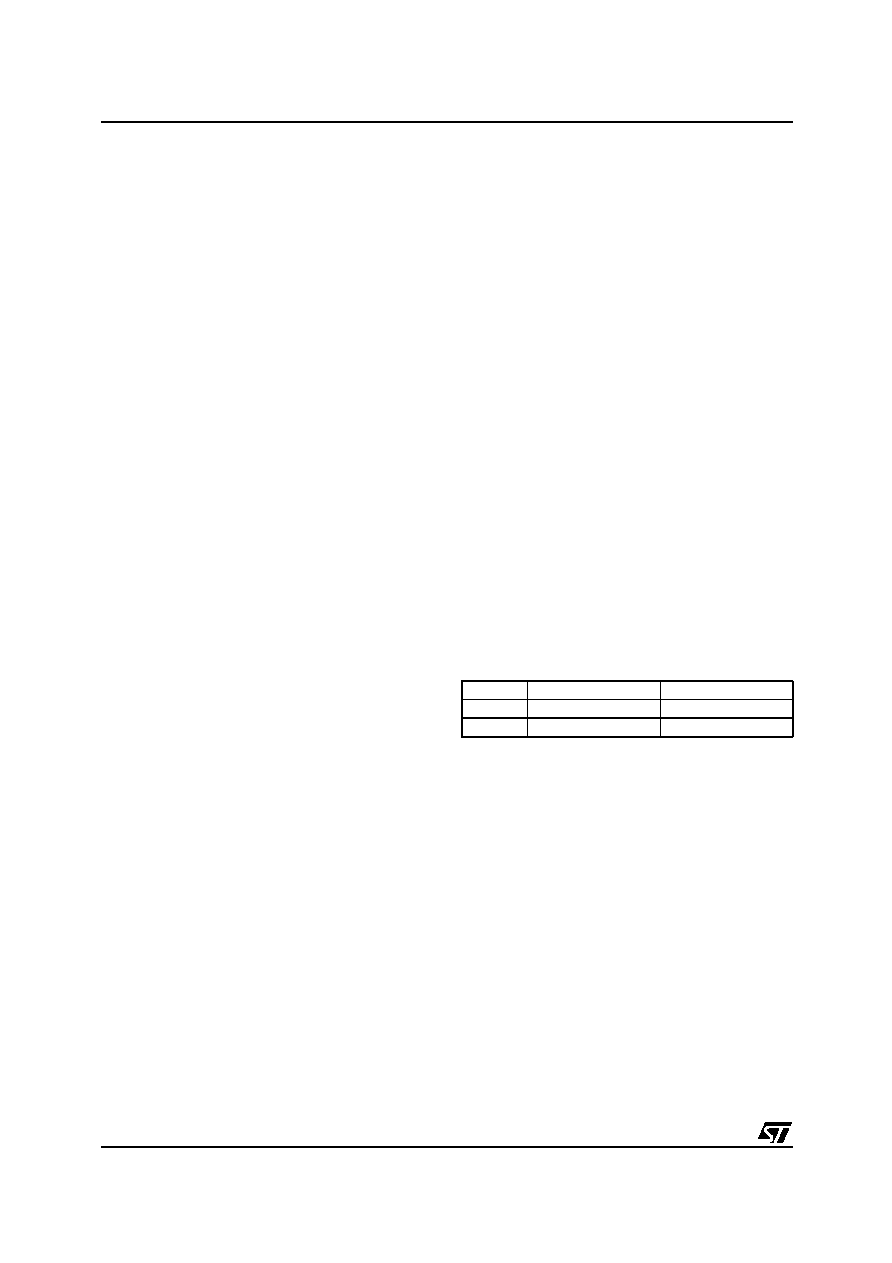- 您現(xiàn)在的位置:買(mǎi)賣(mài)IC網(wǎng) > PDF目錄98144 > ST62T03CM6E (STMICROELECTRONICS) 8-BIT, OTPROM, 8 MHz, MICROCONTROLLER, PDSO16 PDF資料下載
參數(shù)資料
| 型號(hào): | ST62T03CM6E |
| 廠商: | STMICROELECTRONICS |
| 元件分類(lèi): | 微控制器/微處理器 |
| 英文描述: | 8-BIT, OTPROM, 8 MHz, MICROCONTROLLER, PDSO16 |
| 封裝: | 0.300 INCH, LEAD FREE, PLASTIC, SOP-16 |
| 文件頁(yè)數(shù): | 31/100頁(yè) |
| 文件大小: | 1440K |
| 代理商: | ST62T03CM6E |
第1頁(yè)第2頁(yè)第3頁(yè)第4頁(yè)第5頁(yè)第6頁(yè)第7頁(yè)第8頁(yè)第9頁(yè)第10頁(yè)第11頁(yè)第12頁(yè)第13頁(yè)第14頁(yè)第15頁(yè)第16頁(yè)第17頁(yè)第18頁(yè)第19頁(yè)第20頁(yè)第21頁(yè)第22頁(yè)第23頁(yè)第24頁(yè)第25頁(yè)第26頁(yè)第27頁(yè)第28頁(yè)第29頁(yè)第30頁(yè)當(dāng)前第31頁(yè)第32頁(yè)第33頁(yè)第34頁(yè)第35頁(yè)第36頁(yè)第37頁(yè)第38頁(yè)第39頁(yè)第40頁(yè)第41頁(yè)第42頁(yè)第43頁(yè)第44頁(yè)第45頁(yè)第46頁(yè)第47頁(yè)第48頁(yè)第49頁(yè)第50頁(yè)第51頁(yè)第52頁(yè)第53頁(yè)第54頁(yè)第55頁(yè)第56頁(yè)第57頁(yè)第58頁(yè)第59頁(yè)第60頁(yè)第61頁(yè)第62頁(yè)第63頁(yè)第64頁(yè)第65頁(yè)第66頁(yè)第67頁(yè)第68頁(yè)第69頁(yè)第70頁(yè)第71頁(yè)第72頁(yè)第73頁(yè)第74頁(yè)第75頁(yè)第76頁(yè)第77頁(yè)第78頁(yè)第79頁(yè)第80頁(yè)第81頁(yè)第82頁(yè)第83頁(yè)第84頁(yè)第85頁(yè)第86頁(yè)第87頁(yè)第88頁(yè)第89頁(yè)第90頁(yè)第91頁(yè)第92頁(yè)第93頁(yè)第94頁(yè)第95頁(yè)第96頁(yè)第97頁(yè)第98頁(yè)第99頁(yè)第100頁(yè)

ST6200C/ST6201C/ST6203C
36/100
8 I/O PORTS
8.1 INTRODUCTION
Each I/O port contains up to 8 pins. Each pin can
be programmed independently as digital input
(with or without pull-up and interrupt generation),
digital output (open drain, push-pull) or analog in-
put (when available).
The I/O pins can be used in either standard or al-
ternate function mode.
Standard I/O mode is used for:
– Transfer of data through digital inputs and out-
puts (on specific pins):
– External interrupt generation
Alternate function mode is used for:
– Alternate signal input/output for the on-chip
peripherals
The generic I/O block diagram is shown in Figure
8.2 FUNCTIONAL DESCRIPTION
Each port is associated with 3 registers located in
Data space:
– Data Register (DR)
– Data Direction Register (DDR)
– Option Register (OR)
Each I/O pin may be programmed using the corre-
sponding register bits in the DDR, DR and OR reg-
isters: bit x corresponding to pin x of the port. Table
8 illustrates the various port configurations which
can be selected by user software.
During MCU initialization, all I/O registers are
cleared and the input mode with pull-up and no in-
terrupt generation is selected for all the pins, thus
avoiding pin conflicts.
8.2.1 Digital Input Modes
The input configuration is selected by clearing the
corresponding DDR register bit.
In this case, reading the DR register returns the
digital value applied to the external I/O pin.
Different input modes can be selected by software
through the DR and OR registers, see Table 8.
External Interrupt Function
All input lines can be individually connected by
software to the interrupt system by programming
the OR and DR registers accordingly. The inter-
rupt trigger modes (falling edge, rising edge and
low level) can be configured by software for each
port as described in the Interrupt section.
8.2.2 Analog Inputs
Some pins can be configured as analog inputs by
programming the OR and DR registers according-
ly, see Table 8. These analog inputs are connect-
ed to the on-chip 8-bit Analog to Digital Converter.
Caution: ONLY ONE pin should be programmed
as an analog input at any time, since by selecting
more than one input simultaneously their pins will
be effectively shorted.
8.2.3 Output Modes
The output configuration is selected by setting the
corresponding DDR register bit. In this case, writ-
ing to the DR register applies this digital value to
the I/O pin through the latch. Then, reading the DR
register returns the previously stored value.
Two different output modes can be selected by
software through the OR register: push-pull and
open-drain.
DR register value and output pin status:
Note: The open drain setting is not a true open
drain. This means it has the same structure as the
push-pull setting but the P-buffer is deactivated.
To avoid damaging the device, please respect the
VOUT absolute maximum rating described in the
Electrical Characteristics section.
8.2.4 Alternate Functions
When an on-chip peripheral is configured to use a
pin, the alternate function (timer input/output...) is
not systematically selected but has to be config-
ured through the DDR, OR and DR registers. Re-
fer to the chapter describing the peripheral for
more details.
DR
Push-pull
Open-drain
0VSS
VSS
1VDD
Floating
1
相關(guān)PDF資料 |
PDF描述 |
|---|---|
| ST62T10BM6 | 8-BIT, OTPROM, 8 MHz, MICROCONTROLLER, PDSO20 |
| ST62T25BB6 | 8-BIT, OTPROM, 8 MHz, MICROCONTROLLER, PDIP28 |
| ST62T20BB6 | 8-BIT, OTPROM, 8 MHz, MICROCONTROLLER, PDIP20 |
| ST62T18CB6 | 8-BIT, OTPROM, 8 MHz, MICROCONTROLLER, PDIP20 |
| ST62T18CM3 | 8-BIT, OTPROM, 8 MHz, MICROCONTROLLER, PDSO20 |
相關(guān)代理商/技術(shù)參數(shù) |
參數(shù)描述 |
|---|---|
| ST62T08CB6 | 功能描述:8位微控制器 -MCU OTP EPROM 1K SPI/UAR RoHS:否 制造商:Silicon Labs 核心:8051 處理器系列:C8051F39x 數(shù)據(jù)總線(xiàn)寬度:8 bit 最大時(shí)鐘頻率:50 MHz 程序存儲(chǔ)器大小:16 KB 數(shù)據(jù) RAM 大小:1 KB 片上 ADC:Yes 工作電源電壓:1.8 V to 3.6 V 工作溫度范圍:- 40 C to + 105 C 封裝 / 箱體:QFN-20 安裝風(fēng)格:SMD/SMT |
| ST62T08CB6 | 制造商:STMicroelectronics 功能描述:IC 8BIT MCU OTP 1K 62T08 DIP20 |
| ST62T08CM6 | 功能描述:8位微控制器 -MCU OTP EPROM 1K SPI/UAR RoHS:否 制造商:Silicon Labs 核心:8051 處理器系列:C8051F39x 數(shù)據(jù)總線(xiàn)寬度:8 bit 最大時(shí)鐘頻率:50 MHz 程序存儲(chǔ)器大小:16 KB 數(shù)據(jù) RAM 大小:1 KB 片上 ADC:Yes 工作電源電壓:1.8 V to 3.6 V 工作溫度范圍:- 40 C to + 105 C 封裝 / 箱體:QFN-20 安裝風(fēng)格:SMD/SMT |
| ST62T09CB6 | 功能描述:8位微控制器 -MCU OTP EPROM 1K No Intf RoHS:否 制造商:Silicon Labs 核心:8051 處理器系列:C8051F39x 數(shù)據(jù)總線(xiàn)寬度:8 bit 最大時(shí)鐘頻率:50 MHz 程序存儲(chǔ)器大小:16 KB 數(shù)據(jù) RAM 大小:1 KB 片上 ADC:Yes 工作電源電壓:1.8 V to 3.6 V 工作溫度范圍:- 40 C to + 105 C 封裝 / 箱體:QFN-20 安裝風(fēng)格:SMD/SMT |
| ST62T09CB6 | 制造商:STMicroelectronics 功能描述:IC 8BIT MCU OTP 2K 62T09 DIP20 |
發(fā)布緊急采購(gòu),3分鐘左右您將得到回復(fù)。